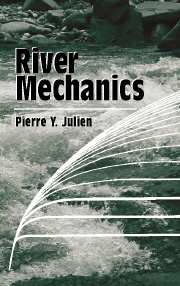Book contents
- Frontmatter
- Contents
- Preface
- Notation
- 1 Introduction to river mechanics
- 2 Physical properties and equations
- 3 River basins
- 4 Steady flow in rivers
- 5 Unsteady flow in rivers
- 6 River equilibrium
- 7 River dynamics
- 8 River stabilization
- 9 River engineering
- 10 Physical river models
- 11 Mathematical river models
- 12 Waves and tides in river estuaries
- Bibliography
- Index
10 - Physical river models
Published online by Cambridge University Press: 05 June 2012
- Frontmatter
- Contents
- Preface
- Notation
- 1 Introduction to river mechanics
- 2 Physical properties and equations
- 3 River basins
- 4 Steady flow in rivers
- 5 Unsteady flow in rivers
- 6 River equilibrium
- 7 River dynamics
- 8 River stabilization
- 9 River engineering
- 10 Physical river models
- 11 Mathematical river models
- 12 Waves and tides in river estuaries
- Bibliography
- Index
Summary
Physical models of rivers have existed at least since 1875, when Louis Jerome Fargue built a model of the Garonne River at Bordeaux. Physical models are usually built to test various river engineering structures and to carry out experiments under controlled laboratory conditions as opposed to costly field programs. The main purposes of physical models include: (1) a small-scale laboratory duplication of a flow phenomenon observed in a river; (2) the examination of the performance of various hydraulic structures or alternative countermeasures to be considered in the final design; and (3) investigation of the model performance under different hydraulic and sediment conditions.
This chapter first describes hydraulic similitude in Section 10.1 in terms of geometric, kinematic, and dynamic similitude. Hydraulic models can be classified into two categories: (1) rigid-bed models, discussed in Section 10.2 and (2) mobile-bed models, discussed in Section 10.3. The analysis leads to the definition of model-scale ratios, and several examples and case studies are presented.
Hydraulic similitude
The prototype conditions, denoted by the subscript p, refer to the full-scale field conditions for which a hydraulic model, subscript m, is to be built in the laboratory. Model scales, subscript r, refer to the ratio of prototype to model conditions. For instance, the gravitational acceleration in the prototype is gp, the gravitational acceleration in the model is gm, and the scale ratio for gravitational acceleration is defined as gr = gp/gm.
- Type
- Chapter
- Information
- River Mechanics , pp. 334 - 351Publisher: Cambridge University PressPrint publication year: 2002



